It began with a typeface. In 2014, typographer and designer Jamie Murphy of the Salvage Press came into possession of a typeface called Caslon, which had its origins in the 1720s. This was the decade in which Jonathan Swift wrote much of his satirical work, including A Modest Proposal, that still-shocking pamphlet that suggests the eating of infants as a solution to Irish poverty. In order to get a feel for the typeface, Jamie used it to publish four pamphlets, each containing a Swift poem. The seeds of an idea had been sown.
"In 2014 my son Joshua was born," said Jamie. "He was worryingly small at birth and was extremely slow to gain weight. We spent the next two years in and out of hospital. I had heard of A Modest Proposal years before but hadn't read it until this period. The text seemed relevant and current – are the Irish not still in a shocking financial condition? Are we not still being plundered by absentee landlords? Are our children not about to incur the fallout from a previous generation's mistakes? I started to think about reprinting the text. My daughter Olivia was born in 2016, presenting signs of the same genetic condition as my son. I knew they would have to be involved, and in one way this project was designed to mark their births."
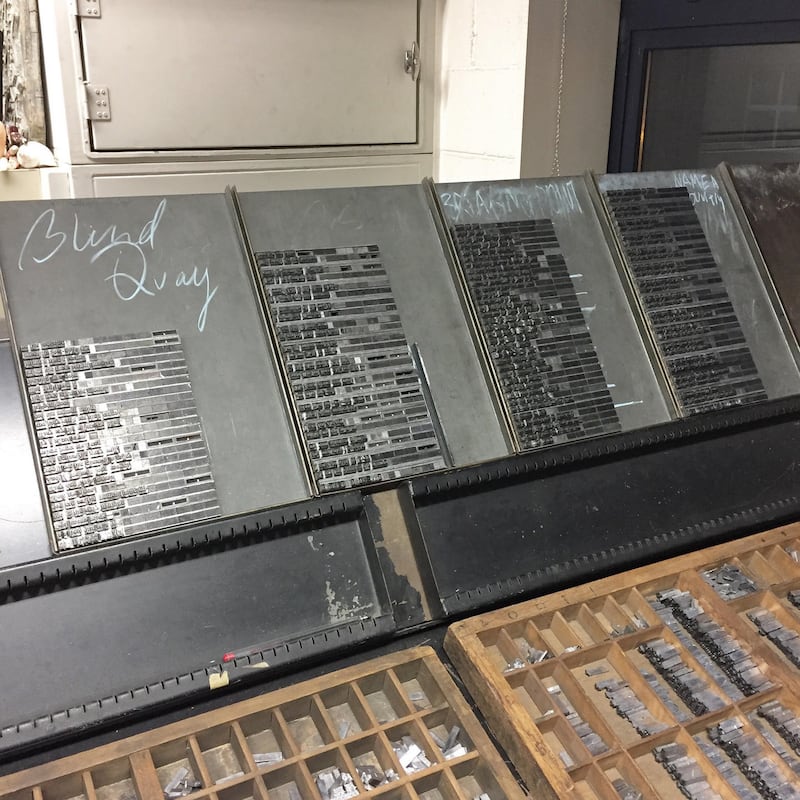
The project began in earnest for Jamie when he was able to access an original printing of the pamphlet, and to get to grips with its quirks.
“On finding that the original printing is a small, crude 16-page pamphlet, seemingly printed in haste, I wanted this book to be at the other end of the spectrum in terms of scale and weight. When it came to working with a text littered with such peculiarities as the extensive use of italics, seemingly unnecessary capitalisation, ligatured sorts, obvious spelling errors and the mixing of roman and italic characters in single words, I was aware that I needed to consider whether to hold onto these nuances. In the end I decided to stay true to the original as much as was possible while pushing the structure in a completely different direction.”
Jamie is always keen to work with other artists, and in this instance he approached David O’Kane to commission a series of lithographs to accompany the text. David’s process involves painstakingly etching his chosen images into stone before printing; a technique that produces haunting results. David had just come back from a research trip to Ethiopia, an experience that primed him for an exploration of Swift’s text.
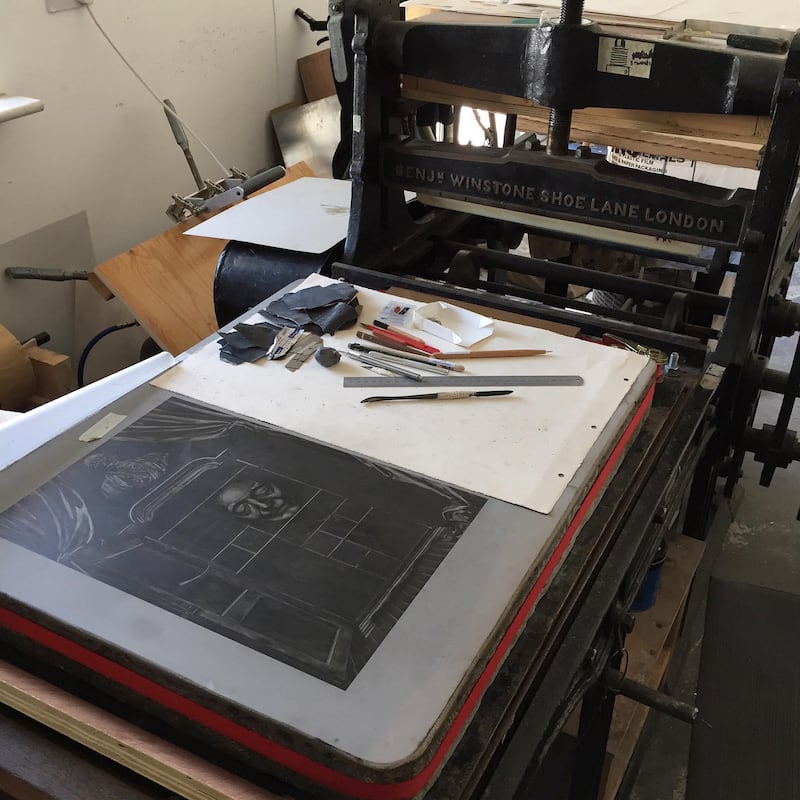

"Visiting the Ethiopian countryside felt like travelling back in time to a pre-industrial age, but there was also the nauseating contrast between some of the more luxury hotels and institutions I visited and the alarming poverty I witnessed. The country is teetering on the brink of famine. It gave me a wider idea of issues of global inequality and poverty. It was highly affecting, but it also went so far beyond my past experience that I felt quite helpless. In a certain sense, Jamie's invitation to create images inspired by A Modest Proposal seemed almost like fate. It gave me a vehicle to channel my feelings through the righteous indignation of Swift's sub-textual voice."
Jamie suggested that David use images of his children Olivia and Joshua as inspiration for the images in the text. This brought the discomfort of the pamphlet’s subject matter into stark focus for David, but ultimately proved invaluable for the creation of the right kind of imagery.
"I was actually quite relieved to have them as models in the end. There aren't many suitable images of infants out there that I could draw upon. There are myriad images from war and famine that I drew upon as general inspiration. I also found 17th- and 18th-century medical illustrations, some of which I incorporated. However, I had quite specific poses in mind for some of the images and I doubt it would be easy to find parents willing to have their baby pose for a project as dark as this. The frontispiece, A Child, Just Dropt, is based on the first photographs Jamie took of Olivia, minutes after she was born."
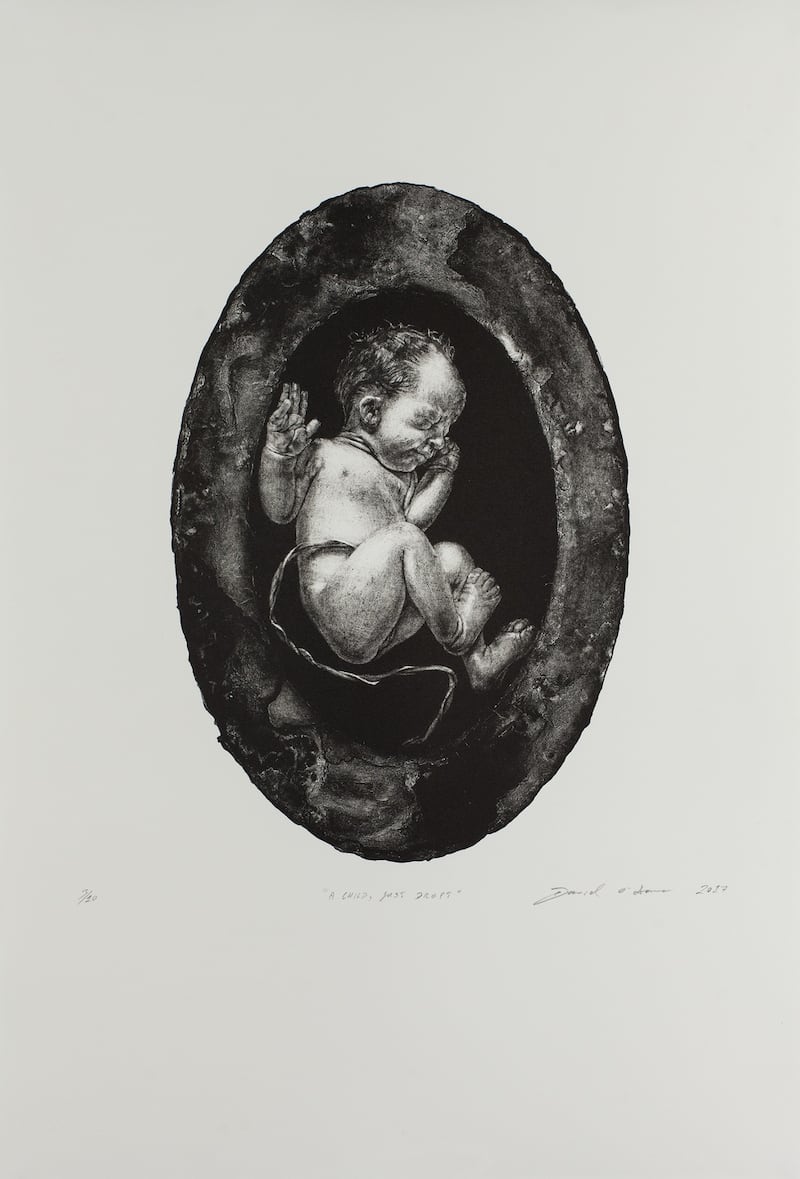
Having spoken to Jamie and David about their work, I took some time to reflect on my own process, which was sparked by Jamie's provocation: "What would Swift write about if he were alive now?" In A Modest Proposal, Swift discusses "the present deplorable state of the kingdom" as if it were a given – I decided to do the same.
So much history unfolded around me as I worked on the poems – the migrant crisis bled into Brexit, bled into the Citizens’ Assembly, bled into the Trump presidency, and I wrote poems in response to all of these events. But it would be impossible to write about the Ireland of the 21st century without writing about direct provision. Strangely, the most biting moment of Swift’s satire is arguably not his suggestion to farm children for food, but the moment in the text where he knowingly lists and then brushes aside practical suggestions on how to improve the lot of the Irish. Reading it again, I couldn’t help but think that the continued use of direct provision in this country seemed as grotesquely contrary as the moment in Swift’s satire where he exhorts the reader:
“Therefore let no man talk to me of other expedients: Of taxing our Absentees at five Shillings a pound: […] Of quitting our Animosities, and Factions, […] Of being a little Cautious not to Sell our Country and Consciences for nothing: Of teaching Landlords to have at least one degree of Mercy towards their Tenants.”
I explored the Asylum Archive website, which captures the true desolation of the asylum-seeker's experience. One image in particular stayed with me: a cardboard clock, the numbers on its face drawn in marker by a child, lying abandoned against a wall, a symbol of the time that's been stolen from entire families by the Irish State.
The Camp
People once came here on holidays.
Can you imagine?
The earth's navel on view
outside the window, grass pocked
with mud, and nothing for miles
but bad weather. Its
When asylum seekers came
someone wired the walls
with a hundred flat black eyes –
how bored they must have been,
these cameras, watching
the slow waltz of imprisonment,
the petty squabbles,
the shudder of a waking body
on a cold morning, the horizon lifting
like a cat's third eyelid
above the frozen ground,
the glare of a bare light bulb
casting tableaux behind families
hunched over scheduled dinners,
as tablets rattle in medication vials,
and children squall until a door is slammed.
Who was the monster at the centre
of this maze?
Nothing left now but a cardboard clock,
an abandoned lesson,
its numbers unravelling,
spooling outwards
all the way from one to thirty-three,
until it loses hope.
The image of the clock from the poem became central to one of David's images, and I in turn couldn't have written my poem The Waiting Table without the inspiration of David's deanery dining table image. David commented on this exchange as we talked:
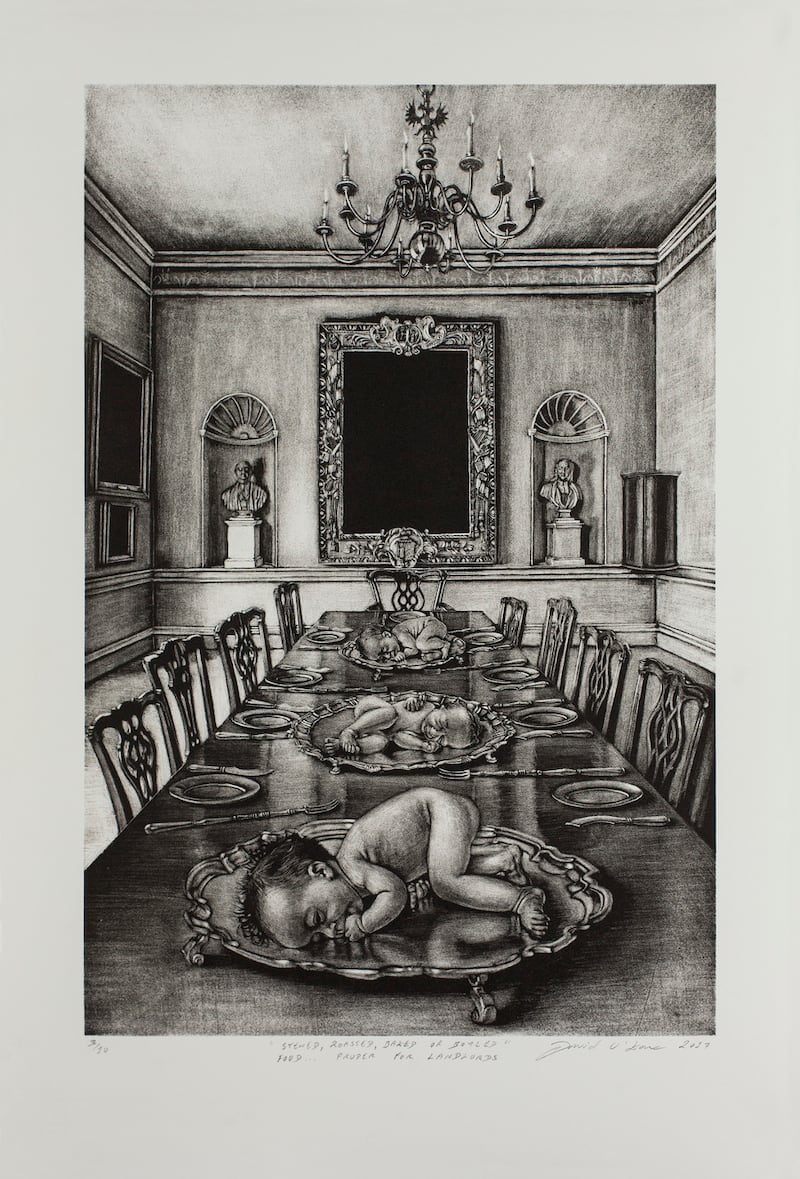
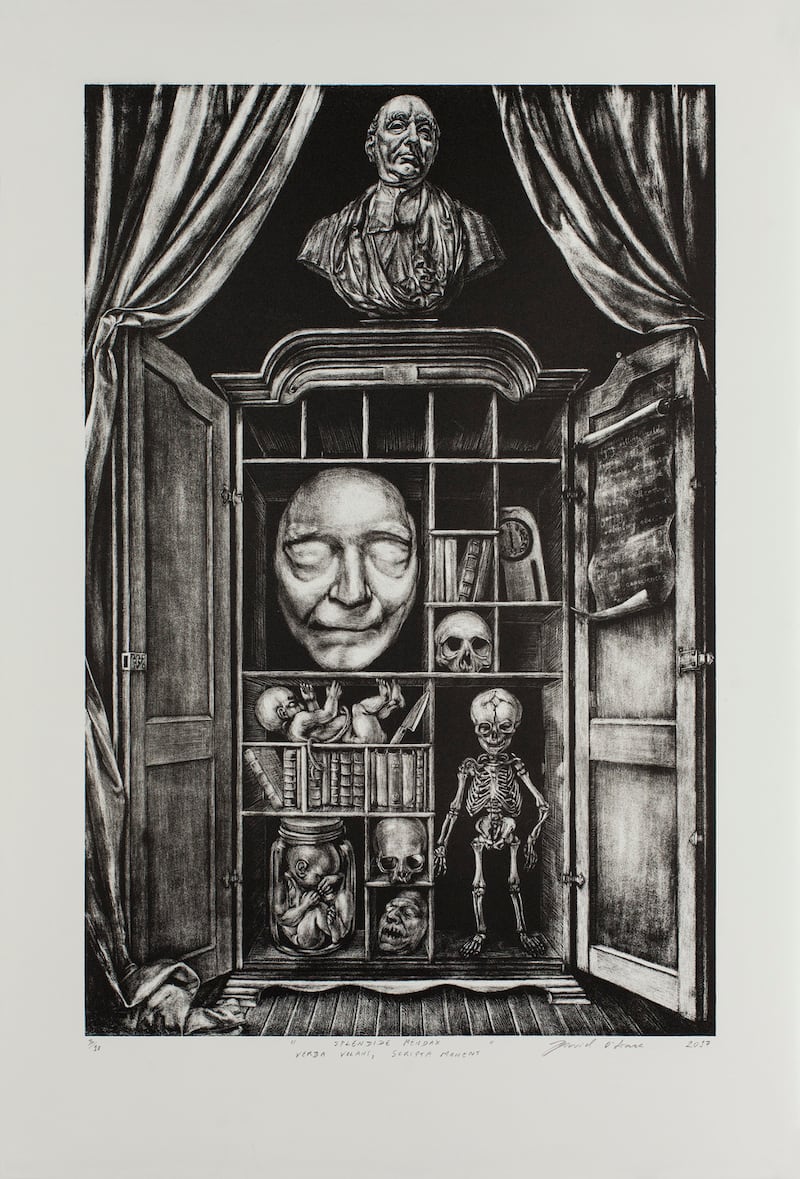
"Some of the images make direct reference to your poems or were directly inspired by them. In Splendide Mendax – Verba Volant, Scripta Manent the crude clock alludes to the found object that inspired your poem, The Camp. One of the strongest emotions generated by the text is righteous indignation. Your poetry provides a delicate emotional complexity that brings the text right up to date and affected me in a very different way. I hope that my images are nestled somewhere in between these two voices, strengthened by both."
Jamie, David and I spent some time considering what A Modest Proposal had helped us discover about the Ireland of today. We all shared the sense of surprise at how urgent both the tone and content of Swift's text still feels. In Jamie's words:
“What is evident on reading the text is that in fact the same issues are present in modern Ireland – we have outdated and damaging laws and attitudes towards immigration, asylum seekers, the homeless, the impoverished, a complete lack of affordable housing, a morally dubious and dangerous attitude to abortion and women’s health, and have witnessed a generation who have sold their children out to foreign banks in their own quest for wealth. The class divide has never been greater. This project is a reflection of those issues through the collaborative efforts of those involved.”
David agrees, while considering the systemic issues that have given rise to these intergenerational echoes; the sense that while our society has changed since Swift’s time, certain trends remain the same.
“Swift’s voice was critical of those in power but also of the exploited masses and their deference to that power. In this sense it is still critically relevant today. The baby in the deanery dining table image appears to be eating her own hand, while simultaneously pointing an accusatory hand toward the viewer. The empty chairs await the hungry landlords. The question raised by the image is whether we want to pull up a seat at this horrific meal or find another way of setting out the table?”
The Waiting Table
When all else fails, there is this:
a table set for dinner.
See how the sunlight
flares the mahogany to blazing red,
how it glimmers on china
that holds the memory
of a hundred bloody repasts.
How alien, how elegant the cutlery;
imagine the weight of the fork in your hand,
the bitter prongs you slide
across your tongue. If you could paint,
you might cast this scene
as a memento mori; the light blushing
the claret jug to clotted garnet,
the yellowed gleam of the silver,
the grapes in the bowl clouded with sweat,
and somewhere, amongst the piled fruit,
the cyan floss of rot.
But you will never need to paint this;
it comes to you whenever you are hungry,
the polite and comforting ritual
of slaughter. The universal need to eat.
In the baroque shade, among the portraits,
the other diners murmur to one another,
and you know you and your fatted heart
will never be alone.












